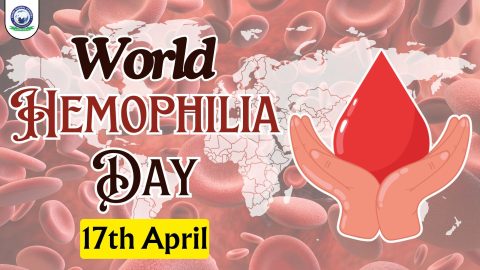Every year on April 17, World Hemophilia Day is observed. This day is dedicated to supporting and raising awareness for individuals affected by hemophilia and other bleeding disorders. The main goal of this day is to educate the general public about this rare disease, improve the quality of life of patients, and unite global efforts for better treatment and care.
History of World Hemophilia Day
World Hemophilia Day was first observed in 1989 by the World Federation of Hemophilia (WFH). This date was chosen to honor the birthday of Frank Schnabel, the founder of WFH. WFH is a global organization that works to raise awareness about hemophilia and other bleeding disorders and helps in making treatment accessible.
What is Hemophilia?
Hemophilia is a genetic blood disorder in which the blood has a reduced or absent ability to clot properly. This means that in case of an injury, the bleeding lasts longer and takes more time to stop. The disorder primarily affects males, while females are usually carriers of the disease.
- There are two main types of hemophilia:
- Hemophilia A: Caused by a deficiency of clotting factor VIII.
- Hemophilia B: Caused by a deficiency of clotting factor IX.
- Symptoms
- Prolonged bleeding after injuries
- Frequent nosebleeds
- Swelling, pain, and bleeding in joints
- Excessive bleeding even from minor injuries
- Blood pooling in muscles
- Causes
- Hemophilia is a hereditary (genetic) disorder passed from parents to children. It is related to the X-chromosome. If the mother is a carrier and the son inherits the affected X chromosome, he can be born with hemophilia.
- Treatment
Currently, there is no permanent cure for hemophilia, but it can be managed effectively with the following:
- Factor replacement therapy
- Injecting clotting factors as needed
- Medications for pain and inflammation
- Physiotherapy, especially after joint bleeding
- Maintaining hygiene to prevent infections
Importance of this Day
To spread awareness about hemophilia and other bleeding disorders
To support patients and their families
To improve medical facilities and access to treatment
To draw the attention of governments and health institutions
World Hemophilia Day 2025 Theme
The World Federation of Hemophilia (WFH) has chosen this year’s theme as:
“Access for All: Women and Girls Bleed Too.” This powerful message highlights a serious and often overlooked reality in our society.
Even today, women and girls with bleeding disorders (WGBDs) remain underdiagnosed and underserved. It is a critical issue that requires a united global effort.
WFH’s message emphasizes that through recognition, proper diagnosis, effective treatment, and ongoing care, the lives of these women and girls can be improved, and the overall bleeding disorders community can become stronger.
Hemophilia in India
In India, it is estimated that there are more than 120,000 people with hemophilia, but only a small portion are officially registered. Organizations like the Hemophilia Federation India (HFI) are working actively to raise awareness, provide support, and offer free treatment to those in need.
- How to Raise Awareness?
- Organizing awareness campaigns in schools and colleges
- Sharing accurate information on social media
- Conducting blood donation camps
- Setting up medical camps
- Sharing patient stories to inspire and educate the community
Conclusion
Hemophilia is a serious but manageable condition. World Hemophilia Day offers an important opportunity to educate people, foster empathy, and support patients in living a healthier and more dignified life. It is not just a one-day observance, but a movement that aims to create a safer and more inclusive world for those living with bleeding disorders.





